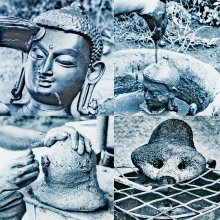Hollow: 2 definitions
Introduction:
Hollow means something in Hinduism, Sanskrit. If you want to know the exact meaning, history, etymology or English translation of this term then check out the descriptions on this page. Add your comment or reference to a book if you want to contribute to this summary article.
Images (photo gallery)
In Hinduism
Natyashastra (theatrics and dramaturgy)
Source: Shodhganga: Elements of Art and Architecture in the Trtiyakhanda of the Visnudharmottarapurana (natya)A Hollow (of the hands) is denoted by the Sanskrit term Añjali, whereas Añjalīhasta refers to one of the thirteen Combined-hand Gestures (in Indian Dramas) (known as saṃyuktahastas), according to the Viṣṇudharmottarapurāṇa, an ancient Sanskrit text which (being encyclopedic in nature) deals with a variety of cultural topics such as arts, architecture, music, grammar and astronomy.—The word añjali denotes a cavity made by folding and joining the open hands together or the hollow of the hands. According to the Viṣṇudharmottarapurāṇa, añjalīhasta is a combination of patākahasta which is used in the salutation of gods, teachers and ancestors. The Abhinayadarpaṇa also gives its view point in the same way.

Natyashastra (नाट्यशास्त्र, nāṭyaśāstra) refers to both the ancient Indian tradition (shastra) of performing arts, (natya—theatrics, drama, dance, music), as well as the name of a Sanskrit work dealing with these subjects. It also teaches the rules for composing Dramatic plays (nataka), construction and performance of Theater, and Poetic works (kavya).
Vastushastra (architecture)
Source: Shodhganga: Elements of Art and Architecture in the Trtiyakhanda of the Visnudharmottarapurana (vastu)Hollow trees should not be used for gathering Wood as a Material for the Construction of Temples, according to the Viṣṇudharmottarapurāṇa, an ancient Sanskrit text which (being encyclopedic in nature) deals with a variety of cultural topics such as arts, architecture, music, grammar and astronomy.—Finding of proper types of materials is one of the important aspects for any construction. In the Viṣṇudharmottarapurāṇa, the architect is suggested to go to the forest to collect appropriate wood for temples in an auspicious day after taking advice from an astrologer. The woods of the trees which are [e.g., hollow from inside, etc.] are totally discarded for making temples. [...] The eco-friendly suggestions of Viṣṇudharmottarapurāṇa are seen to protect the greenery and to balance a pollution free environment.

Vastushastra (वास्तुशास्त्र, vāstuśāstra) refers to the ancient Indian science (shastra) of architecture (vastu), dealing with topics such architecture, sculpture, town-building, fort building and various other constructions. Vastu also deals with the philosophy of the architectural relation with the cosmic universe.
See also (Relevant definitions)
Starts with: Hollow heart, Hollow stalk, Hollow tree, Hollow-stemmed asphodel, Hollowed clausena, Hollowstem.
Full-text (+1101): Kotara, Susira, Nadaka, Vrikshavasa, Tarukotara, Devakhata, Anjali, Gajaputa, Kuhara, Sthuloccaya, Kulitatte, Shunyamadhya, Mandra, Jaghanakupaka, Khekhiraka, Kolapa, Randhravamsha, Karakosha, Varakarani, Dholara.
Relevant text
Search found 190 books and stories containing Hollow; (plurals include: Hollows). You can also click to the full overview containing English textual excerpts. Below are direct links for the most relevant articles:
Hollowness < [April – June, July – September 1978]
Medaram Jatra < [April – June, 2002]
To a Poet Friend < [July-September 1942]
Temples in and around Madurantakam (by B. Mekala)
Evolution of Temples in Tamil Nadu < [Chapter 2 - Temples: Role and Influence]
Asvalayana-grihya-sutra (by Hermann Oldenberg)
Animal Kingdom (Tiryak) in Epics (by Saranya P.S)
Mahabharata (English) (by Kisari Mohan Ganguli)
Section V < [Anusasanika Parva]
Section CCLXXV < [Draupadi-harana Parva]
Section CXXXVII < [Sambhava Parva]
Rasa Jala Nidhi, vol 3: Metals, Gems and other substances (by Bhudeb Mookerjee)
Part 18 - Iron variety (d): Mandura iron < [Chapter IV - Metals (4): Lauha (iron)]




